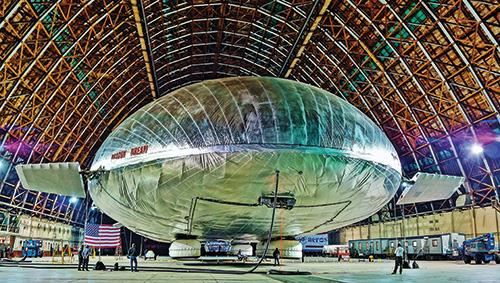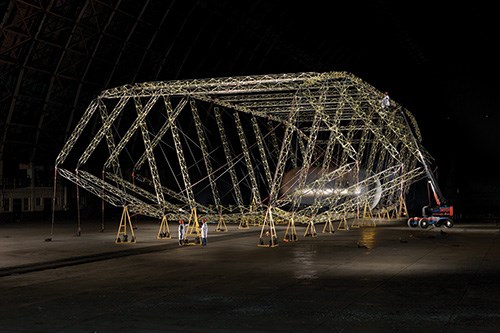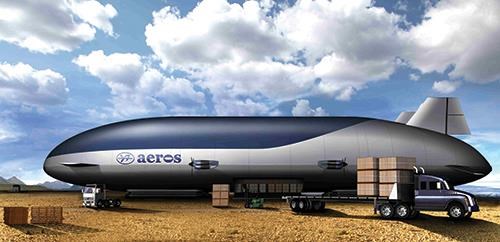Don’t call it a blimp!
The builders of this variable-buoyancy craft count on carbon fiber/epoxy trusswork to enable a new era of air transport.
Airships have been an important part of modern aviation since Count Ferdinand von Zeppelin envisioned the first such craft in 1874. Zeppelin’s design, which involved a rigid framework that supported the outer envelope or skin, meant that an airship could be made much larger and support more load than a simple gas-filled blimp.
Unfortunately, Zeppelin could not obtain helium (only available from sources outside Germany, it was embargoed because of Hitler’s armed buildup) and risked the use of flammable hydrogen. The Hindenburg tragedy in May 1937 and the onset of World War II ended Zeppelin’s successful and fashionable transatlantic flights, and heavier-than-air craft came to dominate the airways. Yet, the allure of airships lived on in the imagination.
Igor Pasternak, for one, imagines a new generation of airships with greatly expanded capabilities. He’s the founder, CEO and chief engineer at Worldwide Aeros Corp. (Aeros, Montbello, Calif.). Fascinated by lighter-than-air craft since childhood, Pasternak formed his first airship company in Ukraine, during the mid-1980s. After moving the company to the U.S. in 1994, he was able to secure funding through the development and sale of tethered military aerostats (lighter-than-air aerodynamic balloons) as well as conventional U.S. Federal Aviation Admin. (FAA)-certified airships. In 2005, he won a U.S. Defense Advanced Research Projects Agency (DARPA) contract to develop a strategic airlifter for possible military use.
The DARPA funds offered a chance to develop something radically new. Traditional blimps use helium-filled flexible envelope to provide lift, but need ground crews and tethers to stabilize the craft. Newer “hybrid” helium airships feature aerodynamic lifting surfaces and require a runway for takeoffs and landings. But when either type is used to carry cargo, the load has to be compensated for during offloading by ballast, typically sandbags or sometimes water, to combat the static lift of the gas. Ballast exchange management is difficult and is the reason that large airships have never been successful cargo carriers. Pasternak and his design team envisioned, instead, a rigid, variable-buoyancy airship, equipped with short side fins, vertical stabilizers and vertical takeoff and landing ability that requires no ballast. Although the DARPA military program ultimately ended, Aeros is endeavoring to build a fleet of what are now called Aeroscraft for commercial cargo roles. Its half-scale prototype, Dragon Dream, has successfully passed several tests and liftoff demonstrations.
Control of static heaviness
Aeros thinks big: Even the Dragon Dream prototype is 266 ft/82m long with a wingspan of 110 ft/34m, and more than 50 ft/15.4m tall. But two mammoth cargo craft have been designed: One 550 ft/169m long with a wingspan of 177 ft/54.5m and height of 120 ft/37m, will carry 132,000 lb (59.9 metric tonnes) of cargo, and a second, larger craft that will haul 500,000 lb (226.8 metric tonnes).
So what makes this concept, recognized by the U.S. Department of Defense and the U.S. Congress as worthy of further study, viable? That would be the central design element, Aeros’ patent-pending “control of static heaviness (COSH)” system. Similar to a submarine’s buoyancy system, says Tim Kenny, Aeros’ engineering department director, it features a pumping system that can capture the helium within the vessel’s envelope and compress it inside numerous holding tanks. When compressed, the gas becomes much heavier, and its containment creates a partial vacuum inside the airship envelope. Air is permitted to enter that void and inflate four large “expansion bladders” positioned along the vessel sides. The air inside the bladders plus the weight of the compressed helium causes a decrease in buoyancy, and the craft descends. When the helium is released back into the envelope, forcing the air bladders to empty, the airship ascends. Airship elevation is maintained and rate of ascent/descent is controlled via the helium’s tank vs. envelope balance. The system renders ground tethering crews and ballasting unnecessary, and opens the way for cargo transport to remote and unimproved locations.
Key to the concept’s success is the craft’s rigid internal structure, which must support not only the weight of the cargo, but the heavy COSH helium pump, compressors and storage tanks. Early trade studies showed that carbon/epoxy tubes in various diameters, assembled to form an airy truss skeleton (see photo, at left), could provide sufficient support at minimal weight. To shave cost during the demonstrator phase, some anodized aluminum tubing is used with the carbon, but Aeros intends to field future airships with all-carbon trusses.
“We ultimately determined that a truss design was the best way to handle bending loads, after multiple design iterations,” says Kenny. “We have divided the truss into sections, similar to a bridge design.” Carbon fiber/epoxy tubes in a range of diameters from 0.5 inch/12.5 mm up to 4 inches/100 mm, as well as some heftier square tube profiles, are assembled, together with the aluminum tubing, to form truss sections. The larger tubing is used, he explains, where loads are heavier, under the compressor equipment and engines, and where lifting or bending loads are anticipated to be the greatest. Sections are connected by complex tubular aluminum joints — the adhesive layer isolates the carbon and aluminum, preventing galvanic corrosion.
Aeros used Solidworks software from Dassault Systèmes (Waltham, Mass.) for the truss design, and conducted finite element analysis (FEA) of the entire structure under cargo-loading and bending conditions, using Nastran FEA software from NEi Software (Westminster, Calif.).
A new way to carry cargo
The majority of the composites comprise the truss structure, but other composite elements include the instrument panel, honeycomb-cored glass and carbon fiber cockpit floor panels and abrasion-resistant aramid fiber-reinforced composite fabrics on the craft’s ground-contact pads. Kenny reveals that in the full-scale airships, the outer skin might be made with more durable, rigid, lightweight composite panels, rather than the mylar film employed in the demonstrator.
The Dragon Dream successfully lifted off in 2013, says Aeros’ director of communications John Kiehle. Since then, Aeros has inked four memoranda of understanding with cargo transporters Pacific Airlift, Cargolux Airlines, Air Charter Service and Bertling Logistics, to explore shipping possibilities — Aeros intends to lease, not sell, the craft and will act as fleet operator. Target markets include oil and gas and wind energy (transport of blades and towers). The goal, says Kiehle, is FAA certification by 2016, and an active fleet soon thereafter.
Related Content
Plant tour: Albany Engineered Composites, Rochester, N.H., U.S.
Efficient, high-quality, well-controlled composites manufacturing at volume is the mantra for this 3D weaving specialist.
Read MoreThe potential for thermoplastic composite nacelles
Collins Aerospace draws on global team, decades of experience to demonstrate large, curved AFP and welded structures for the next generation of aircraft.
Read MoreMcLaren celebrates 10 years of the McLaren P1 hybrid hypercar
Lightweight carbon fiber construction, Formula 1-inspired aerodynamics and high-performance hybrid powertrain technologies hallmark this hybrid vehicle, serve as a springboard for new race cars.
Read MoreComposites manufacturing for general aviation aircraft
General aviation, certified and experimental, has increasingly embraced composites over the decades, a path further driven by leveraged innovation in materials and processes and the evolving AAM market.
Read MoreRead Next
“Structured air” TPS safeguards composite structures
Powered by an 85% air/15% pure polyimide aerogel, Blueshift’s novel material system protects structures during transient thermal events from -200°C to beyond 2400°C for rockets, battery boxes and more.
Read MorePlant tour: Daher Shap’in TechCenter and composites production plant, Saint-Aignan-de-Grandlieu, France
Co-located R&D and production advance OOA thermosets, thermoplastics, welding, recycling and digital technologies for faster processing and certification of lighter, more sustainable composites.
Read MoreAll-recycled, needle-punched nonwoven CFRP slashes carbon footprint of Formula 2 seat
Dallara and Tenowo collaborate to produce a race-ready Formula 2 seat using recycled carbon fiber, reducing CO2 emissions by 97.5% compared to virgin materials.
Read More



























